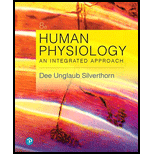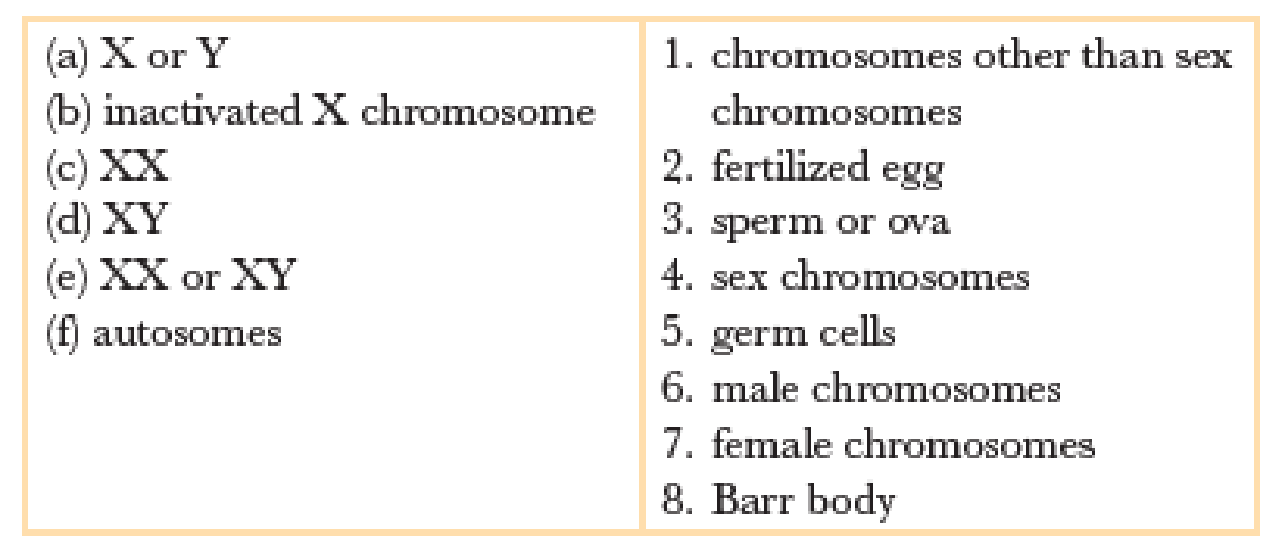
Match each of the following items with all the terms it applies to:

To match: Each item with the applicable terms.
Answer to Problem 1RQ
Correct answer:
| (a) X or Y | 3. sperm and ova, 4. sex chromosomes, 5. germ cells |
| (b) Inactivated X chromosome | 8. Barr body |
| (c) XX | 2. fertilized egg, 7. female chromosomes |
| (d) XY | 2. fertilized egg, 6. male chromosomes |
| (e) XX or XY | 2. fertilized egg |
| (f) Autosomes | 1. chromosomes other than sex chromosomes |
Explanation of Solution
- (a) X or Y – 3. sperm and ova, 4. sex chromosomes, 5. germ cells
The cells which contain half the number of chromosomes are known as germ cells. Sperm and ova are germ cells produced by males and females, respectively. Each germ cell has 23 chromosomes, 22 autosomes, and 1 sex chromosome. Male germ cells (sperms) can have either X or Y chromosome, whereas female germ cells (ova) will always have an X chromosome.
- (b) Inactivated X chromosome – 8. Barr body
Female sex chromosomes have genotype XX. One X out of these is condensed and inactive. It appears to be a small and dense stained structure present in the nuclei of the cells. This inactive and condensed X chromosome is known as a Barr body. Barr bodies are absent in males.
- (c) XX - 2. fertilized egg, 7. female chromosomes
Half of the male germ cells contain an X chromosome, and the other half has Y chromosome. If male germ cell carrying X chromosome fuses with the female germ cell, then the fertilized egg would have XX chromosomes. Presence of XX chromosomes indicates that the fetus is female.
- (d) XY - 2. fertilized egg, 6. male chromosomes
X and Y chromosomes are sex chromosomes present in humans. The fusion of male germ cell containing Y chromosome and female germ cell would result in the production of zygote with genotype XY.
- (e) XX or XY – 2. fertilized egg
In humans, male and female germ cells have 1 sex chromosome each. About 50% of male germ cells have X chromosome whereas the other 50% has Y chromosome. All the female germ cells have X chromosome in them. The fusion of male and female germ cells inside the female body is known as fertilization. The zygote formed after fertilization has double chromosomes as compared to the germ cells. This zygote or fertilized egg will have genotype XX in case of females and XY in case of males.
- (f) Autosomes – 1.chromosomes other than sex chromosomes
Every human being has 46 chromosomes that is 23 pairs of chromosomes. Out of these 23 pairs, 22 are autosomes, and 1 pair of the chromosome is sex chromosome. Autosomes are responsible for various features of the human body such as eye color, height, hair color, and many more.
Want to see more full solutions like this?
Chapter 26 Solutions
Human Physiology: An Integrated Approach (8th Edition)
Additional Science Textbook Solutions
Human Biology: Concepts and Current Issues (8th Edition)
Physics for Scientists and Engineers: A Strategic Approach, Vol. 1 (Chs 1-21) (4th Edition)
Human Anatomy & Physiology (2nd Edition)
Campbell Biology (11th Edition)
College Physics: A Strategic Approach (3rd Edition)
Anatomy & Physiology (6th Edition)
- Molecular Biology Please help with question. Thank you in advance. Discuss, compare and contrast the structure of promoters inprokaryotes and eukaryotes.arrow_forwardMolecular Biology Please help with question. Thank you You are studying the expression of the lac operon. You have isolated mutants as described below. In the absence of glucose, explain/describe what would happen, for each mutant, to the expression of the lac operon when you add lactose AND what would happen when the bacteria has used up all of the lactose (if the mutant is able to use lactose).1. Mutations in the lac repressor gene that would prevent the binding of lactose2. Mutations in the lac repressor gene that would prevent release of lactose once lactose hadbound3. Normally the lac repressor gene is located next to (a few hundred base pairs) and upstreamfrom the lac operon. Mutations in the lac repressor gene that move the lac repressor gene 100,000base pairs downstream.4. Mutations in the lac operator that would prevent binding of lac repressorarrow_forwardYou have returned to college to become a phylogeneticist. One of the first things you wish to do is determine how mammals, birds, and reptiles are related. Like any good scientist, you need to consider all available data objectively and without a preconceived “correct” answer. In pursuit of that, you should produce a phylogenetic tree based only on morphological features that show birds and mammals are more closely related. You will then produce a totally different tree, also using morphological features, that shows birds and reptiles are more closely related. Do not forget to include all three groups in both your trees. Based solely off the trees you produce, which relationship would you consider the more likely and why? Once you have answered that question, provide a brief summary of the “modern” understanding of the relationship between these three groups.arrow_forward
- true or false, the reason geckos can walk on walls is hydrogen bonding between their foot pads and the moisture on the wall.arrow_forwardBiology laboratory problem Please help. thank you You have 20 ul of DNA solution and 6X DNA loading buffer solution. You have to mix your DNA solution and DNA loading buffer before load DNA in an agarose gel. The concentration of the DNA loading buffer must be 1X in the DNA and DNA-loading buffer mixture after you mix them. For that, I will add _____ ul of 6X loading buffer to the 20 ul DNA solution.arrow_forwardBiology lab problem To make 20 ul of 5 mM MgCl2 solution using 50 mM MgCl2 stock solution and distilled water, I will mix ________ ul of 50 mM MgCl2 solution and ________ ul of distilled water. Please help . Thank youarrow_forward
- Biology Please help. Thank you. Biology laboratory question You need 50 ml of 1% (w/v) agarose gel. Agarose is a powder. How would you make it? You can ignore the volume of agarose powder. Don't forget the unit.TBE buffer is used to make an agarose gel, not distilled water. I will add _______ of agarose powder into 50 ml of distilled water (final 50 ml).arrow_forwardAn urgent care center experienced the average patient admissions shown in the Table below during the weeks from the first week of December through the second week of April. Week Average Daily Admissions 1-Dec 11 2-Dec 14 3-Dec 17 4-Dec 15 1-Jan 12 2-Jan 11 3-Jan 9 4-Jan 9 1-Feb 12 2-Feb 8 3-Feb 13 4-Feb 11 1-Mar 15 2-Mar 17 3-Mar 14 4-Mar 19 5-Mar 13 1-Apr 17 2-Apr 13 Forecast admissions for the periods from the first week of December through the second week of April. Compare the forecast admissions to the actual admissions; What do you conclude?arrow_forwardAnalyze the effectiveness of the a drug treatment program based on the needs of 18-65 year olds who are in need of treatment by critically describing 4 things in the program is doing effectively and 4 things the program needs some improvement.arrow_forward
- I have the first half finished... just need the bottom half.arrow_forward13. Practice Calculations: 3 colonies were suspended in the following dilution series and then a viable plate count and microscope count was performed. Calculate IDF's, TDF's and then calculate the CFU/mL in each tube by both methods. Finally calculate the cells in 1 colony by both methods. Show all of your calculations in the space provided on the following pages. 3 colonies 56 cells 10 μL 10 μL 100 μL 500 με m OS A B D 5.0 mL 990 με 990 με 900 με 500 μL EN 2 100 με 100 μL 118 colonies 12 coloniesarrow_forwardDescribe and give a specific example of how successionary stage is related to species diversity?arrow_forward
 Human Biology (MindTap Course List)BiologyISBN:9781305112100Author:Cecie Starr, Beverly McMillanPublisher:Cengage LearningCase Studies In Health Information ManagementBiologyISBN:9781337676908Author:SCHNERINGPublisher:Cengage
Human Biology (MindTap Course List)BiologyISBN:9781305112100Author:Cecie Starr, Beverly McMillanPublisher:Cengage LearningCase Studies In Health Information ManagementBiologyISBN:9781337676908Author:SCHNERINGPublisher:Cengage





